10 Things We Learned From WWE SummerSlam 1988
Randy Savage didn't like the plans for Miss Elizabeth...

Jul 21, 2018
The year 1988 gave us three truly incredible things: the Die Hard movie franchise, Nintendo Power magazine, and SummerSlam. Yes, the final tentpole of WWE's Big Four pay-per-view package was stuck into the ground, premiering on Monday 29 August 1988 from Madison Square Garden in New York City.
The first SummerSlam would be headlined by a tag team match pitting The Mega Powers (WWE Champion 'Macho Man' Randy Savage and Hulk Hogan) against The Mega Bucks (Ted DiBiase and Andre the Giant). Jesse 'The Body' Ventura would preside over that match as special referee, while 'Superstar' Billy Graham would replace the future Governor on commentary. Let's just say that having Ventura return to pay-per-view broadcasting at that year's Survivor Series made our turkey dinners taste all the better.
Like the original WrestleMania that took place in the same building, the first SummerSlam wasn't a particularly good event from a wrestling standpoint, but it holds up as a curiosity, the first of its kind.
1988's show will begin this series of lookbacks at WWE's August supercard, highlighting some little-known facts, and adding some further context and perspective, as we look back at every single SummerSlam there has ever been.
[embed
[/embed]
If you're a fan of a certain age, you miss the pay-per-view theme songs that would be used annually for each of those Big Four events. That lively saxophone song for the old Survivor Series events comes to mind, as well as the gritty majesty of "The Grand Spectacle", the theme for WrestleManias VI through X.
Firing up SummerSlam 1988 on WWE Network gives those nostalgic ears a sweet dose of memory candy, as following a Gorilla Monsoon-narrated shot of New York City at dusk, we get the official intro, soundtracked by a tropical-sounding bit of light rock fused with hard rock (medium rock?). That particular song would be used for the 1988-89 SummerSlams, before migrating over to the Royal Rumble, for which it would serve as *that* event's theme song from 1991 to 1994. Seriously, tell me this song isn't infectious. If you're between ages 31 and 44, you either wanna beat Honky Tonk Man for the IC title, or you wanna yell "HAKUUUUUU!" in Vince's voice.
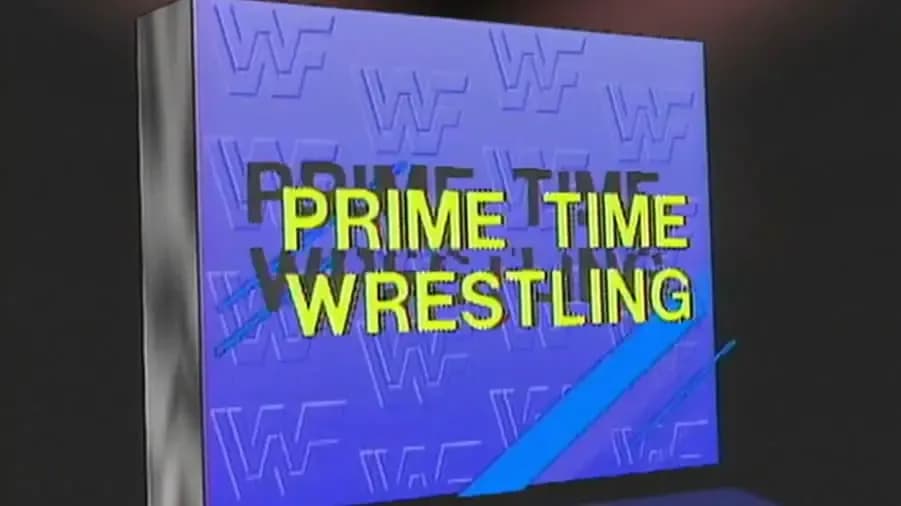
It'd have been kinda hard to imagine WWE doing this in another era, and still feels even weird to read about in what may as well be the ancient year of 1988. From 20 September through 18 October, episodes Prime Time Wrestling would show a different match from SummerSlam as the final bout of the weekly two-hour USA Network broadcast.
None of the matches were what one would consider top-of-the-card action, though the five-show run did include the British Bulldogs vs. Fabulous Rougeau Brothers 20-minute draw, as well as the Rick Rude vs. Junkyard Dog match in which Jake Roberts ran in for the DQ finish. If you've ever seen Prime Time on the Network (or even in its heyday), you're aware that taped matches could be culled from a variety of sources, such as recent MSG and Boston Garden events, as well as fare from the weekend syndicated shows. So maybe it wasn't all that unusual for WWE to air lower-card SummerSlam matches for free.

Comparing 1984 WWE and 1989 WWE as two side-by-side portraits makes one aware of just how much things had changed in five years. Sure, The Hulkster was still A-Number-One, but the gradual roster turnover would spell out the biggest difference. SummerSlam 1988 would prove to be all but the last hurrah for a number of mid-eighties regulars, while a few colourful stars of a more gimmicky WWE would begin to make their own names.
Veteran holdovers like Don Muraco, Ken Patera, Junkyard Dog, and Dynamite Kid would all be wrestling on their last, or next-to-last, WWE pay-per-view at that SummerSlam and all would be gone before the end of November 1988 - and none of them were victorious in their particular bouts. Meanwhile, the likes of Big Boss Man and The Powers of Pain would make their pay-per-view debuts, winning in convincing fashion. As for The Ultimate Warrior, well, let's just say he looked especially strong in what was his second pay-per-view outing.

In the days of only three or four pay-per-views a year, WWE would use only WrestleMania and SummerSlam as events where long-running feuds would be blown off, or decisively concluded. Otherwise, it was all about arena business, as the monthly Madison Square Garden shows, et al, would generally be the locales for final confrontations.
That's why it was also a bit unusual for SummerSlam 1988 to feature only one match with a long-simmering grudge of any note, that being the big tag team main event. To give you an example of how times were different, Jake Roberts and Rick Rude were four months deep into a heated feud, stemming from Rude making unwanted passes at Roberts' wife Cheryl. Yet, SummerSlam saw them set apart, with Rude facing JYD and Roberts wrestling Hercules. The two did interact when Roberts jumped Rude at the end of his match, but that was the extent of their SummerSlam paths crossing. And speaking of Rude vs. Roberts...

You had to take your excitement where you could get it with the first SummerSlam, and as mentioned, the ending of the Rude-JYD match saw Roberts get involved, ramping up the conflict between he and "Ravishing Rick". The impetus for Roberts' interference was a nifty bit of brilliance that, according to Bruce Prichard, came from the brain of one Pat Patterson.
Rude was known for wearing tights with custom airbrush designs that taunted his specific upper-card opponents, but it was a hidden pair that caught Roberts' ire. As Rude ascended the ropes to land a flying attack, he lowered the waistband of his tights to reveal a second pair underneath, these tights displaying the face of Cheryl Roberts on his crotch and ass. Seething with rage, Roberts hit the ring in order to assault Rude, shoring up the intensity of their feud. That sort of dickish brilliance on the part of Rude is the stuff of legend, and Mr Patterson certainly deserves a hearty golf clap for coming up with it.
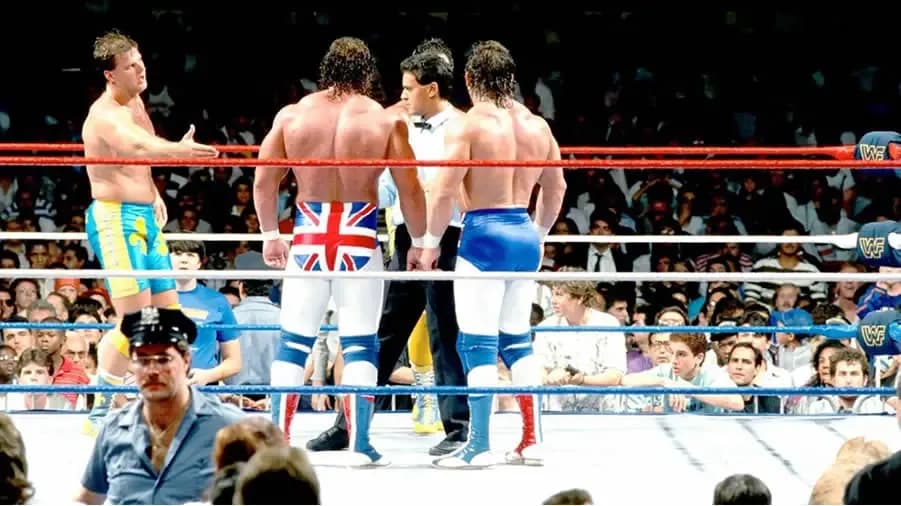
This is not a Survivor Series-related list, but attention must be called to the 1987 and 1988 Thanksgiving spectaculars. On both shows, there were matches pitting five babyface tag teams against five heel duos, spelling out just how incredible the tag scenes were in that era. In 1988 alone, Demolition, The Hart Foundation, The Rockers, The British Bulldogs, The Islanders, The Brain Busters, The Rougeaus, The Killer Bees, among others, occupied the WWE roster, and all brought the goods in two-on-two combat - a golden age for tag wrestling.
It then comes as little surprise that SummerSlam 88's three best matches were of the tag team variety. The Bulldogs and Rougeaus' opener was 20 minutes of fluid tag action, and dig the Garden crowd when Dynamite Kid catches that early hot tag. The Demolition/Harts Tag Team title bout was the sort of action you'd expect from two duos at their respective apexes. Finally, the Mega Powers/Mega Bucks main event was a suitably-exciting finish to the night, the perfect go-home match. We need for a SummerSlam to kick off with The Usos vs. The Revival some time.
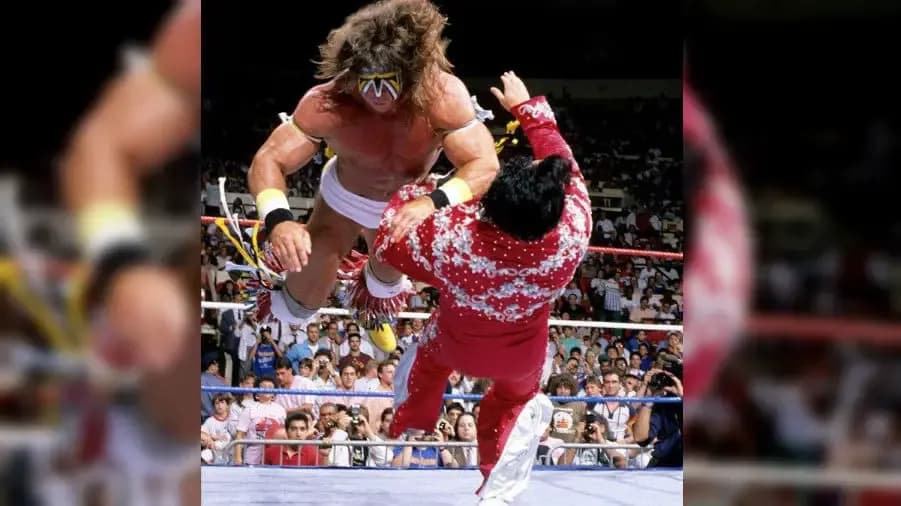
The biggest highlight of SummerSlam 1988 is, of course, Ultimate Warrior accepting IC Champion Honky Tonk Man's arrogant open challenge, demolishing the eternal champion in 30 seconds to win the belt. The fans went insane for the title change, not just because Warrior was a star on the rise, but because he'd demolished a man that was a thorn in their side for all too long, and did so with ease. It's among the greatest title changes ever.
Interestingly, fans who attended WWE's TV tapings the previous week had a window into the SummerSlam plans. At both the Superstars and Challenge sessions, Warrior pinned Honky in untelevised matches to
win
the belt, so that he could appear with the gold when he taped his matches later in the night (said matches would be airing in September, after SummerSlam, so Warrior *had* to appear as champion). Then, at the end of those nights, it was announced that the belt was being returned to Honky on a technicality. It may sound convoluted, but it was definitely a masterstroke on WWE's part to work around their taping schedule in that manner.
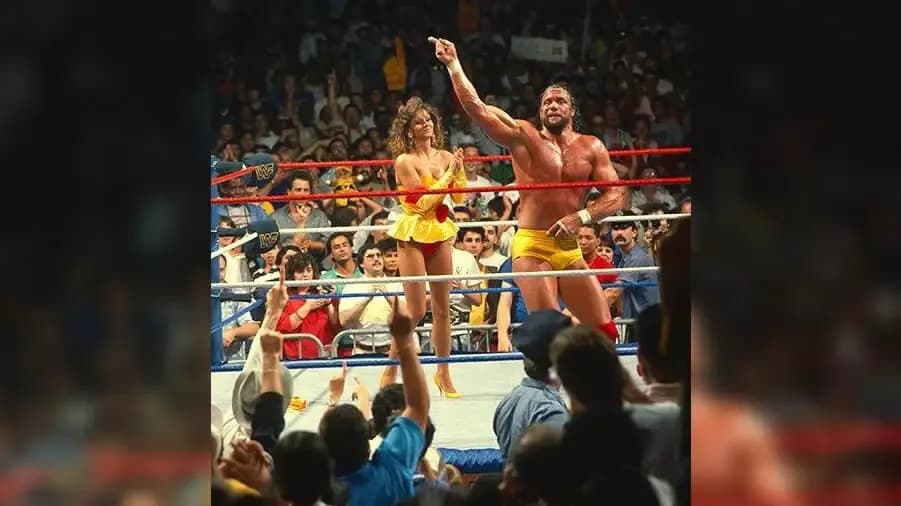
The main event match in which Hogan and Savage vanquished DiBiase and Andre was most notable for the finishing sequence. Just when it seemed as though the heroes were teetering on the brink, an immaculately-dressed Miss Elizabeth climbed to the apron and stripped off her skirt, revealing red full-bottoms, the sight of which would distract the heels, their seconds (Bobby Heenan and Virgil), and referee Ventura. Hogan and Savage would use the diversion to turn the tide, though Savage's flying elbow would only be the second best visual of that entire portion of the match.
According to Bruce Prichard, Miss Elizabeth's clothing reveal was originally supposed to be a skimpier bikini, but Savage flat out refused to let that come to pass. Ultimately, Vince and Savage managed to come to an agreement on the somewhat conservative bottoms, though the bikini idea was apparently in play up until the final days before SummerSlam, where Savage suddenly got cold feet. As Prichard notes, one of their top-selling posters featured Liz in a bikini, so he's not sure why Savage grew so skittish.
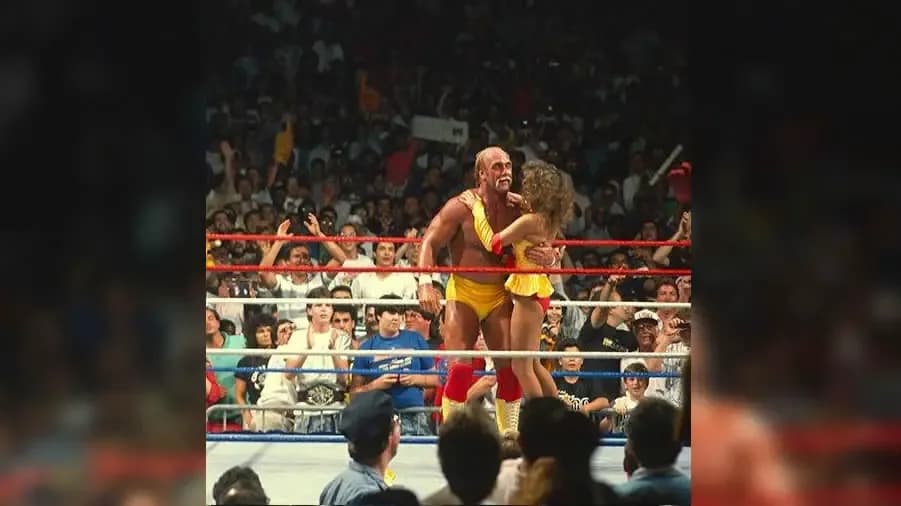
Really, in 1988, fans were probably so jubilant over a Mega Powers victory that most didn't catch the little bit of subtlety in their celebration. As Hogan and Savage soaked in the adulation along with Elizabeth, there came a moment when Hogan scooped Liz up in a celebratory hug, acknowledging her role as the weapon of mass distraction. As Hogan finished twirling her, Savage turned to the pair and briefly held his arms out, as if to say "What the hell?" The two were celebrating like chums seconds later, but Savage's eyes still wore a pronounced befuddlement.
The paranoia on Savage's part really took root on that night, and would continue to manifest until he finally turned on Hogan more than five months later at The Main Event in Milwaukee. The distance between SummerSlam 1988 and WrestleMania V was about seven months, but the foundation for the championship match was already being laid.
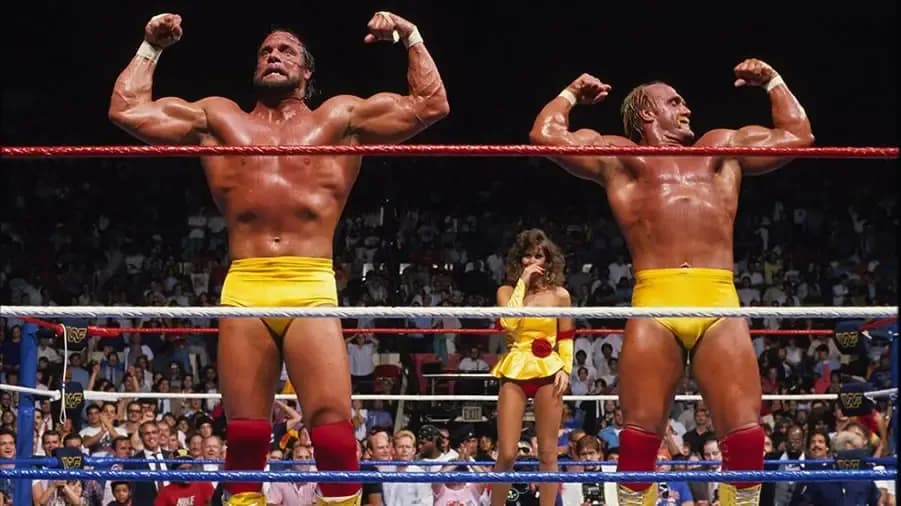
SummerSlam 1988 was only the sixth pay-per-view offering on WWE's part, following WrestleManias 2, III, and IV (the original was exclusive to closed-circuit theaters), Survivor Series 1987, and the 1985 Wrestling Classic. As the pay-per-view market continued to grow later in the eighties, WWE was apt to compliment WrestleMania with three other annual events that would comprise that mythical Big Four. The early returns for SummerSlam demonstrated promise.
In all, SummerSlam 1988 did 400,000 buys, an 18 per cent drop-off from 'Mania 4's 485,000, but tied 'Mania 3, and was up 23 per cent from Survivor Series 1987's 325,000 buys. While WrestleMania would remain the alpha and the omega of the pay-per-view calendar, having a summer-ending extravaganza (along with a Thanksgiving night team-based event and a creative battle royal concept in January) would only dot the wrestling fan's calendar with substantial landmarks.
The year 1988 gave us three truly incredible things: the Die Hard movie franchise, Nintendo Power magazine, and SummerSlam. Yes, the final tentpole of WWE's Big Four pay-per-view package was stuck into the ground, premiering on Monday 29 August 1988 from Madison Square Garden in New York City.
The first SummerSlam would be headlined by a tag team match pitting The Mega Powers (WWE Champion 'Macho Man' Randy Savage and Hulk Hogan) against The Mega Bucks (Ted DiBiase and Andre the Giant). Jesse 'The Body' Ventura would preside over that match as special referee, while 'Superstar' Billy Graham would replace the future Governor on commentary. Let's just say that having Ventura return to pay-per-view broadcasting at that year's Survivor Series made our turkey dinners taste all the better.
Like the original WrestleMania that took place in the same building, the first SummerSlam wasn't a particularly good event from a wrestling standpoint, but it holds up as a curiosity, the first of its kind.
1988's show will begin this series of lookbacks at WWE's August supercard, highlighting some little-known facts, and adding some further context and perspective, as we look back at every single SummerSlam there has ever been.
[embed
[/embed]
If you're a fan of a certain age, you miss the pay-per-view theme songs that would be used annually for each of those Big Four events. That lively saxophone song for the old Survivor Series events comes to mind, as well as the gritty majesty of "The Grand Spectacle", the theme for WrestleManias VI through X.
Firing up SummerSlam 1988 on WWE Network gives those nostalgic ears a sweet dose of memory candy, as following a Gorilla Monsoon-narrated shot of New York City at dusk, we get the official intro, soundtracked by a tropical-sounding bit of light rock fused with hard rock (medium rock?). That particular song would be used for the 1988-89 SummerSlams, before migrating over to the Royal Rumble, for which it would serve as *that* event's theme song from 1991 to 1994. Seriously, tell me this song isn't infectious. If you're between ages 31 and 44, you either wanna beat Honky Tonk Man for the IC title, or you wanna yell "HAKUUUUUU!" in Vince's voice.

It'd have been kinda hard to imagine WWE doing this in another era, and still feels even weird to read about in what may as well be the ancient year of 1988. From 20 September through 18 October, episodes Prime Time Wrestling would show a different match from SummerSlam as the final bout of the weekly two-hour USA Network broadcast.
None of the matches were what one would consider top-of-the-card action, though the five-show run did include the British Bulldogs vs. Fabulous Rougeau Brothers 20-minute draw, as well as the Rick Rude vs. Junkyard Dog match in which Jake Roberts ran in for the DQ finish. If you've ever seen Prime Time on the Network (or even in its heyday), you're aware that taped matches could be culled from a variety of sources, such as recent MSG and Boston Garden events, as well as fare from the weekend syndicated shows. So maybe it wasn't all that unusual for WWE to air lower-card SummerSlam matches for free.

Comparing 1984 WWE and 1989 WWE as two side-by-side portraits makes one aware of just how much things had changed in five years. Sure, The Hulkster was still A-Number-One, but the gradual roster turnover would spell out the biggest difference. SummerSlam 1988 would prove to be all but the last hurrah for a number of mid-eighties regulars, while a few colourful stars of a more gimmicky WWE would begin to make their own names.
Veteran holdovers like Don Muraco, Ken Patera, Junkyard Dog, and Dynamite Kid would all be wrestling on their last, or next-to-last, WWE pay-per-view at that SummerSlam and all would be gone before the end of November 1988 - and none of them were victorious in their particular bouts. Meanwhile, the likes of Big Boss Man and The Powers of Pain would make their pay-per-view debuts, winning in convincing fashion. As for The Ultimate Warrior, well, let's just say he looked especially strong in what was his second pay-per-view outing.

In the days of only three or four pay-per-views a year, WWE would use only WrestleMania and SummerSlam as events where long-running feuds would be blown off, or decisively concluded. Otherwise, it was all about arena business, as the monthly Madison Square Garden shows, et al, would generally be the locales for final confrontations.
That's why it was also a bit unusual for SummerSlam 1988 to feature only one match with a long-simmering grudge of any note, that being the big tag team main event. To give you an example of how times were different, Jake Roberts and Rick Rude were four months deep into a heated feud, stemming from Rude making unwanted passes at Roberts' wife Cheryl. Yet, SummerSlam saw them set apart, with Rude facing JYD and Roberts wrestling Hercules. The two did interact when Roberts jumped Rude at the end of his match, but that was the extent of their SummerSlam paths crossing. And speaking of Rude vs. Roberts...

You had to take your excitement where you could get it with the first SummerSlam, and as mentioned, the ending of the Rude-JYD match saw Roberts get involved, ramping up the conflict between he and "Ravishing Rick". The impetus for Roberts' interference was a nifty bit of brilliance that, according to Bruce Prichard, came from the brain of one Pat Patterson.
Rude was known for wearing tights with custom airbrush designs that taunted his specific upper-card opponents, but it was a hidden pair that caught Roberts' ire. As Rude ascended the ropes to land a flying attack, he lowered the waistband of his tights to reveal a second pair underneath, these tights displaying the face of Cheryl Roberts on his crotch and ass. Seething with rage, Roberts hit the ring in order to assault Rude, shoring up the intensity of their feud. That sort of dickish brilliance on the part of Rude is the stuff of legend, and Mr Patterson certainly deserves a hearty golf clap for coming up with it.

This is not a Survivor Series-related list, but attention must be called to the 1987 and 1988 Thanksgiving spectaculars. On both shows, there were matches pitting five babyface tag teams against five heel duos, spelling out just how incredible the tag scenes were in that era. In 1988 alone, Demolition, The Hart Foundation, The Rockers, The British Bulldogs, The Islanders, The Brain Busters, The Rougeaus, The Killer Bees, among others, occupied the WWE roster, and all brought the goods in two-on-two combat - a golden age for tag wrestling.
It then comes as little surprise that SummerSlam 88's three best matches were of the tag team variety. The Bulldogs and Rougeaus' opener was 20 minutes of fluid tag action, and dig the Garden crowd when Dynamite Kid catches that early hot tag. The Demolition/Harts Tag Team title bout was the sort of action you'd expect from two duos at their respective apexes. Finally, the Mega Powers/Mega Bucks main event was a suitably-exciting finish to the night, the perfect go-home match. We need for a SummerSlam to kick off with The Usos vs. The Revival some time.

The biggest highlight of SummerSlam 1988 is, of course, Ultimate Warrior accepting IC Champion Honky Tonk Man's arrogant open challenge, demolishing the eternal champion in 30 seconds to win the belt. The fans went insane for the title change, not just because Warrior was a star on the rise, but because he'd demolished a man that was a thorn in their side for all too long, and did so with ease. It's among the greatest title changes ever.
Interestingly, fans who attended WWE's TV tapings the previous week had a window into the SummerSlam plans. At both the Superstars and Challenge sessions, Warrior pinned Honky in untelevised matches to
win
the belt, so that he could appear with the gold when he taped his matches later in the night (said matches would be airing in September, after SummerSlam, so Warrior *had* to appear as champion). Then, at the end of those nights, it was announced that the belt was being returned to Honky on a technicality. It may sound convoluted, but it was definitely a masterstroke on WWE's part to work around their taping schedule in that manner.

The main event match in which Hogan and Savage vanquished DiBiase and Andre was most notable for the finishing sequence. Just when it seemed as though the heroes were teetering on the brink, an immaculately-dressed Miss Elizabeth climbed to the apron and stripped off her skirt, revealing red full-bottoms, the sight of which would distract the heels, their seconds (Bobby Heenan and Virgil), and referee Ventura. Hogan and Savage would use the diversion to turn the tide, though Savage's flying elbow would only be the second best visual of that entire portion of the match.
According to Bruce Prichard, Miss Elizabeth's clothing reveal was originally supposed to be a skimpier bikini, but Savage flat out refused to let that come to pass. Ultimately, Vince and Savage managed to come to an agreement on the somewhat conservative bottoms, though the bikini idea was apparently in play up until the final days before SummerSlam, where Savage suddenly got cold feet. As Prichard notes, one of their top-selling posters featured Liz in a bikini, so he's not sure why Savage grew so skittish.

Really, in 1988, fans were probably so jubilant over a Mega Powers victory that most didn't catch the little bit of subtlety in their celebration. As Hogan and Savage soaked in the adulation along with Elizabeth, there came a moment when Hogan scooped Liz up in a celebratory hug, acknowledging her role as the weapon of mass distraction. As Hogan finished twirling her, Savage turned to the pair and briefly held his arms out, as if to say "What the hell?" The two were celebrating like chums seconds later, but Savage's eyes still wore a pronounced befuddlement.
The paranoia on Savage's part really took root on that night, and would continue to manifest until he finally turned on Hogan more than five months later at The Main Event in Milwaukee. The distance between SummerSlam 1988 and WrestleMania V was about seven months, but the foundation for the championship match was already being laid.

SummerSlam 1988 was only the sixth pay-per-view offering on WWE's part, following WrestleManias 2, III, and IV (the original was exclusive to closed-circuit theaters), Survivor Series 1987, and the 1985 Wrestling Classic. As the pay-per-view market continued to grow later in the eighties, WWE was apt to compliment WrestleMania with three other annual events that would comprise that mythical Big Four. The early returns for SummerSlam demonstrated promise.
In all, SummerSlam 1988 did 400,000 buys, an 18 per cent drop-off from 'Mania 4's 485,000, but tied 'Mania 3, and was up 23 per cent from Survivor Series 1987's 325,000 buys. While WrestleMania would remain the alpha and the omega of the pay-per-view calendar, having a summer-ending extravaganza (along with a Thanksgiving night team-based event and a creative battle royal concept in January) would only dot the wrestling fan's calendar with substantial landmarks.